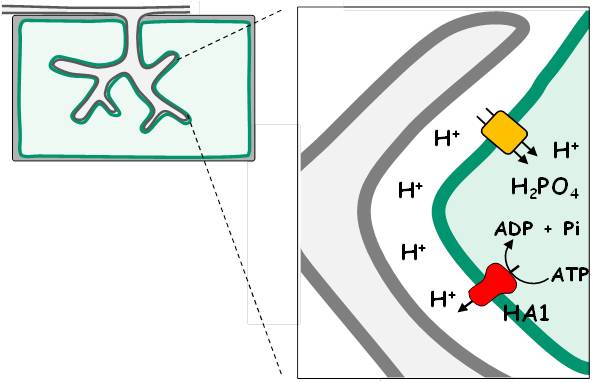Scientists Reveal the Source of Electrochemical Proton Gradient that Drives Nutrient Exchange in Mycorrhizal Symbiosis
Phosphorus and nitrogen are critical macronutrients for plant proper growth. Many fertilisers, such as phosphorus and nitrogen are applied to soil for higher crop yield in agriculture system. But only 30% applied fertilizers are taken up by crops. A beneficial fungus which forms relationships with plant such as Medicago and rice roots is effective at helping plants thrive in nutrients poor conditions, in this process which could reduce the high levels of fertilizers currently used in agriculture system.
The research from the teams led by Prof. Wang Ertao in Shanghai Institutes for Biological Sciences, CAS and Dr. Michael Schultze in Universtiy of York, UK showed that plasma membrane H+-ATPases which are specifically induced in arbuscule-containing cells are required for enhanced proton pumping activity in membrane vesicles from AM-colonized roots of rice (Oryza sativa) and Medicago truncatula. Mutation of the H+-ATPases reduced arbuscule size and impaired nutrient uptake by the host plant through the mycorrhizal symbiosis. Overexpression of the H+-ATPase Os-HA1 increased both phosphate uptake and the plasma membrane potential, suggesting that this H+-ATPase plays a key role in energizing the periarbuscular membrane, thereby facilitating nutrient exchange in arbusculated plant cells.
This work entitled “A H+-ATPase that Energizes Nutrient Uptake during Mycorrhizal Symbioses in Rice and Medicago” has been published online in The Plant Cell on April 30, 2014.

Mechanism of HA1 in mycorrhizal symbiosis(Image by Dr. WANG Ertao 's group)
CONTACT:
WANG Ertao
National Key Laboratory of Plant Molecular Genetics
Institute of Plant Physiology and Ecology, Shanghai Institutes for Biological Sciences, Chinese Academy of Sciences.
Tel: 86-21-54924081; Email: etwang@sibs.ac.cn
